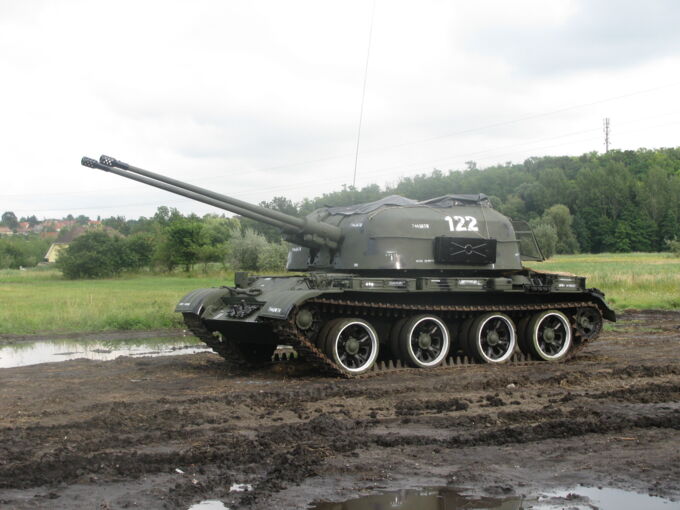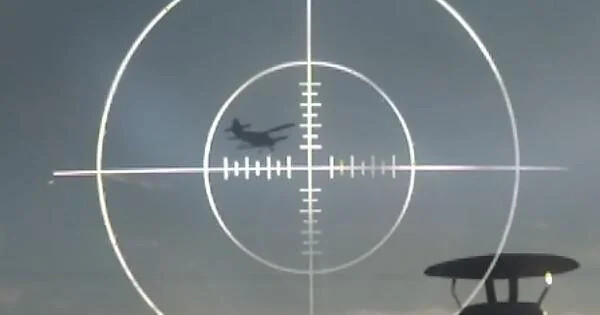The ZSU-57-2 “Sparka” is a Soviet SPAAG (Self Propelled Anti Aircraft Gun). It featured 2 57mm clip-fed autocannons and no radar or IRST. It was manned by a crew of 6 (Driver, gunner, 2 loaders, commander and sight adjuster). It entered service in 1955 and is still in service with some nations (and armed insurgencies) in its original form today, the most notable users being Egypt, Cuba and Hezbollah. Over 2,000 were built in the USSR alone, with more built in North Korea and as a modified variant, the Type 80, in China.
Naming Convention
The “ZSU” in ZSU-57-2 means “Zenitnaya Samokhodnaya Ustanovka”. This translates from Russian to English as “Anti-Aircraft Self Propelled Mount”. The “57” refers to the calibre of the guns, which are both 57mm. The “2” is referring to the number of barrels. This naming convention was and is used for many SPAAG produced in the USSR that use guns and not SAMs.
Development
During WW2, low flying aircraft emerged as a serious threat to mobile ground units and as a result, the SPAAG role became a key part of any armoured force. The first mass produced Soviet SPAAG was the ZSU-37. The dawn of the jet age however, established a requirement for a higher caliber SPAAG. This was due to the higher speed aircraft having a limited window in which they were vulnerable to air defence. This meant the caliber needed to be sufficient to down the aircraft in only one or two hits. This began the development of the ZSU-57-2, which first reaped prototype on a T-54 chassis with the S-68 gun in 1948. Prototypes were produced by 1950 and tested in 1954, since the drives for the S-68 had yet to be developed. The SPAAG finally entered service on 14th of February 1955.
Armament
The most prominent feature of the ZSU-57-2 is its armament. It has 2 S-68 clip-fed autocannons that are reported to fire at a rate of 120 rpm per gun, totaling 240 rpm. The right breech is adapted to fit clips fed through the right hand side, whereas the left breech is fed through the top. The gun, the S-68, is a modified version of the S-60 anti-aircraft gun utilised by many nations. The S-60 first entered service in 1950. The S-68 variant of the gun, found in the ZSU-57-2, featured a unique operating system that used a conveyor belt to remove spent casings from the guns and turret. The casings are removed from the gun via an automatic breech opening system and they fall onto a conveyor belt that runs below the breeches. This belt takes the empty cartridges to the wire basket on the rear of the turret. The vehicle carries 300 rounds of ammunition, contained in 5 round clips. The vehicle fired two main ammunition types, being FRAG-T (Fragmentation-Tracer) and APC-T (Armour Piercing Capped-Tracer). Shells had a muzzle velocity of 1000m/s and had a maximum horizontal range of 12,000m (12km). An interesting note about the sighting system in use in the ZSU-57-2 is that the target data had to be entered manually by a sight adjuster who sat in the rear-left of the turret. It was the sight adjuster’s job to estimate speed, direction and either rangefind or estimate the range of the target.
Hull
The hull of the ZSU-57-2 was that of the T-54 with reduced armour and one less road wheel (4 instead of 5). The vehicle was driven by a rear drive sprocket. It had the same engine as the T-54. This allowed the vehicle to achieve higher speeds than the T-54, thanks to its lighter turret and drastically reduced armour. It had a reported average road speed of 25-40 km/h on dirt and paved road. It had a power to weight ratio of 18.5 hp/t. It weighed 28 tonnes compared to the almost 40 ton T-54. The armour protection was negligible all over the vehicle being at most 15mm, albeit the front plate being angled at 60°.
Usage
The ZSU-57-2 has seen action in several wars, under several flags. It has fought under the Croatian and Israeli flag after being captured and was bought and used by many others, most notably the USSR, Germany, Hungary, Finland, China, Poland, Romania, Serbia, Slovenia, Yugoslavia and Vietnam. The SPAAG fought in many wars, the most famous being the Vietnam War, the Yom Kippur War, the Gulf War and the Yugoslavian War. While its combat record against air targets was dubious at best, the vehicle fared much better against ground targets, which became for many operators, its primary use.
Vietnam
The ZSU-57-2 was used in 1972 and 1975 by the Communist forces. While it was used against US aircraft, it was found to be more effective against ground targets. Of the 500 survivors of the Vietnam War, 200 are believed to still be in service.
Egypt and Syria
Egypt and Syria used the ZSU-57-2 against Israel during the Six Day War (1967) and the Yom Kippur War (1973). They were used in defence of an airfield along with T-34s but were overpowered by Israeli M48s. ZSU-57-2s did not fare well in Egyptian hands. They were later upgraded with radar at an unknown date. The Syrians used them in 1976 during an intervention in Lebanon but the vehicles intended purpose was once again seen to be inadequate when they failed to engage Israeli aircraft. They did however, fare well against the ground targets of the Lebanese Leftists (Communists). The ZSU-57-2s were redeployed by Syria in 2011 during the Syrian civil war. The ZSU-57-2 has been seen in service as late as 2014.
Iran and Iraq
The ZSU-57-2 was employed by both Iran and Iraq during the Iran-Iraq War. The Iraqis also used Type-80 vehicles from China, also known as the WZ305. The Iraqi ZSU-57-2s are believed to have been used against Iranian AH-1J helicopters by receiving radar information from ZSU-23-4 Shilkas or from 9K31/35 Strelas.
Yugoslavia
The ZSU-57-2 was employed by Yugoslavia during the Yugoslav wars against ground targets. Two Croatian captured examples fought in the Croatian War of Independence. The Federal Republic of Yugoslavia (Serbia and Montenegro) utilised the vehicle during the NATO bombing raids in 1999.
Conclusion
The ZSU-57-2 is quite an unusual vehicle in many ways. Its appearance is “unique” and its combat record could be described similarly. It is rather unusual for an SPAAG to become an anti-tank/personnel vehicle. The ZSU-57-2 failed its envisioned purpose due to its lack of any kind of radar but did find itself a niche in the end. A very interesting vehicle with a very interesting history, it is still in service today with some major armies in a modified capacity.




